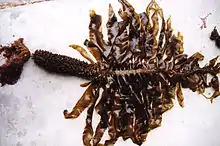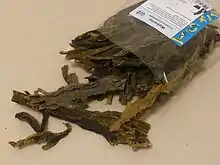Undaria pinnatifida
Undaria pinnatifida aussi connue sous le nom de wakame est une espèce d'algues brunes de la famille des Alariaceae.

Cette espèce d'origine asiatique a été volontairement ou involontairement introduite hors de son aire naturelle de répartition, elle est aujourd'hui par exemple trouvée dans des zones aussi variées que l'Europe (observée depuis le début des années 1990[1] de la Bretagne au littoral sud-anglais[2]) , la Tasmanie[3] et Nouvelle-Zélande[4] ou en Argentine[5]. Elle est signalée depuis le début des années 2000 dans le pacifique nord[6]. Selon une étude faite en Tasmanie, là où elle est introduite, elle s'installe plus facilement dans les environnement déjà perturbés par l'homme[7]





Propriétés, vertus
Certains des composants moléculaires (Fucoxanthines) de cette algue auraient un effet anti-obésité[8] et anti-tumoral [9],[10],[11],[12],[13].
Cette algue contient aussi une peptide qui est un Antihypertenseur[14].
Elle contient aussi une molécule qui présente des propriétés antivirales[15], qui pourrait peut-être permettre de mieux lutter contre l'herpes simplex virus[16].
Usages
C'est une des macroalgues qui est commercialisée sous le nom de wakame, proposée comme ingrédient alimentaire (par exemple dans des pâtes[18]).
C'est aussi l'espèce qui a été choisie par BiotechMarine (filiale de Seppic, basée à Pontrieux en Bretagne) pour en extraire des cellules (gamétophytes en l'occurrence, qui chez la plante sauvage ne vivent que quelques semaines) et en faire une culture cellulaire produisant des principes actifs pour l'industrie des cosmétiques (antioxydants notamment). Selon l'entreprise la culture de cellule de cette algue permettrait de n'en pas surexploiter les stocks et donc de contribuer à préserver la biodiversité marine.
Cette espèce pourrait aussi être étudiée pour extraire certains polluants de l'eau (cuivre et nickel par exemple, par biosorption[19].
Liste des variétés
Selon Catalogue of Life (24 nov. 2012)[20] :
- variété Undaria pinnatifida var. elongata
- variété Undaria pinnatifida var. vulgaris
Notes et références
Références taxonomiques
- (fr) Référence Catalogue of Life : Undaria pinnatifida (Harvey) Suringar (consulté le )
- (fr) Référence DORIS : espèce Undaria pinnatifida (consulté le )
- (fr) Référence SeaLifeBase : (consulté le )
- (en) Référence AlgaeBase : espèce Undaria pinnatifida (Harvey) Suringar (consulté le )
- (en) Référence GISD : espèce Undaria pinnatifida (consulté le )
- (en) Référence World Register of Marine Species : espèce Undaria pinnatifida (Harvey) Suringar, 1873 (consulté le )
- (en) Référence NCBI : Undaria pinnatifida (taxons inclus) (consulté le )
- (en) Référence uBio : Undaria pinnatifida (Harvey) Suringar, 1872 (consulté le )
Notes et références autres que taxonomiques
- Floc'h, J. Y., Pajot, R., & Wallentinus, I. (1991). The Japanese brown alga Undaria pinnatifida on the coast of France and its possible establishment in European waters. Journal du Conseil: ICES Journal of Marine Science, 47(3), 379-390 (résumé).
- Fletcher, R. L., & Manfredi, C. (1995). The occurrence of Undaria pinnatifida (Phaeophyceae, Laminariales) on the south coast of England. Botanica marina, 38(1-6), 355-358 (résumé).
- Sanderson, J. C. (1990). A preliminary survey of the distribution of the introduced macroalga, Undaria pinnatifida (Harvey) Suringer on the east coast of Tasmania, Australia. Botanica marina, 33(2), 153-158 (résumé).
- Hay, C. H., & Luckens, P. A. (1987). The Asian kelp Undaria pinnatifida (Phaeophyta: Laminariales) found in a New Zealand harbour. New Zealand journal of botany, 25(2), 329-332.
- Casas, G. N., & Piriz, M. L. (1996). Surveys of Undaria pinnatifida (Laminariales, Phaeophyta) in Golfo Nuevo, Argentina. Hydrobiologia, 326(1), 213-215.
- Silva, P. C., Woodfield, R. A., Cohen, A. N., Harris, L. H., & Goddard, J. H. (2002). First report of the Asian kelp Undaria pinnatifida in the northeastern Pacific Ocean. Biological Invasions, 4(3), 333-338.
- Valentine, J. P., & Johnson, C. R. (2003). Establishment of the introduced kelp Undaria pinnatifida in Tasmania depends on disturbance to native algal assemblages. Journal of Experimental Marine Biology and Ecology, 295(1), 63-90.
- Maeda, H., Hosokawa, M., Sashima, T., Funayama, K., & Miyashita, K. (2005). Fucoxanthin from edible seaweed, Undaria pinnatifida, shows antiobesity effect through UCP1 expression in white adipose tissues. Biochemical and biophysical research communications, 332(2), 392-397 (résumé).
- Maruyama, H., Tamauchi, H., Hashimoto, M., & Nakano, T. (2002). Antitumor activity and immune response of Mekabu fucoidan extracted from Sporophyll of Undaria pinnatifida. In vivo (Athens, Greece), 17(3), 245-249 (résumé)
- Synytsya, A., Kim, W. J., Kim, S. M., Pohl, R., Synytsya, A., Kvasnička, F., ... & Park, Y. I. (2010). Structure and antitumour activity of fucoidan isolated from sporophyll of Korean brown seaweed Undaria pinnatifida. Carbohydrate Polymers, 81(1), 41-48.
- Maruyama, H., Tamauchi, H., Iizuka, M., & Nakano, T. (2006). The role of NK cells in antitumor activity of dietary fucoidan from Undaria pinnatifida sporophylls (Mekabu). Planta medica, 72(15), 1415-1417.
- Suetsuna, K., & Nakano, T. (2000). Identification of an antihypertensive peptide from peptic digest of wakame (Undaria pinnatifida). The Journal of nutritional biochemistry, 11(9), 450-454 (résumé).
- Vishchuk, O. S., Ermakova, S. P., & Zvyagintseva, T. N. (2011). Sulfated polysaccharides from brown seaweeds Saccharina japonica and Undaria pinnatifida: isolation, structural characteristics, and antitumor activity. Carbohydrate research, 346(17), 2769-2776 ().
- Suetsuna, K., & Nakano, T. (2000). Identification of an antihypertensive peptide from peptic digest of wakame (Undaria pinnatifida). The Journal of nutritional biochemistry, 11(9), 450-454 (résumé)
- Lee, J. B., Hayashi, K., Hashimoto, M., Nakano, T., & Hayashi, T. (2004). Novel antiviral fucoidan from sporophyll of Undaria pinnatifida (Mekabu). Chemical and Pharmaceutical Bulletin, 52(9), 1091-1094.
- Hayashi, K., Nakano, T., Hashimoto, M., Kanekiyo, K., & Hayashi, T. (2008). Defensive effects of a fucoidan from brown alga Undaria pinnatifida against herpes simplex virus infection. International Immunopharmacology, 8(1), 109-116 (résumé).
- Kimura J & Maki N (2002) New loliolide derivatives from the brown alga Undaria pinnatifida. Journal of natural products, 65(1), 57-58 (résumé
- Prabhasankar, P., Ganesan, P., Bhaskar, N., Hirose, A., Stephen, N., Gowda, L. R., ... & Miyashita, K. (2009). Edible Japanese seaweed, wakame (Undaria pinnatifida) as an ingredient in pasta: Chemical, functional and structural evaluation. Food Chemistry, 115(2), 501-508 (résumé).
- Chen, Z., Ma, W., & Han, M. (2008). Biosorption of nickel and copper onto treated alga (Undaria pinnatifida): application of isotherm and kinetic models. Journal of hazardous materials, 155(1), 327-333 (résumé).
- Roskov Y., Ower G., Orrell T., Nicolson D., Bailly N., Kirk P.M., Bourgoin T., DeWalt R.E., Decock W., van Nieukerken E.J., Penev L. (eds.) (2020). Species 2000 & ITIS Catalogue of Life, 2020-12-01. Digital resource at www.catalogueoflife.org. Species 2000: Naturalis, Leiden, the Netherlands. ISSN 2405-8858, consulté le 24 nov. 2012
Liens externes
Bibliographie
- Chen, T., Wong, Y. S., Zheng, W., Bai, Y., & Huang, L. (2008). Selenium nanoparticles fabricated in Undaria pinnatifida polysaccharide solutions induce mitochondria-mediated apoptosis in A375 human melanoma cells. Colloids and surfaces B: Biointerfaces, 67(1), 26-31.]).
- Sato, M., Hosokawa, T., Yamaguchi, T., Nakano, T., Muramoto, K., Kahara, T., ... & Nakano, T. (2002). Angiotensin I-converting enzyme inhibitory peptides derived from wakame (Undaria pinnatifida) and their antihypertensive effect in spontaneously hypertensive rats. Journal of Agricultural and Food Chemistry, 50(21), 6245-6252 (résumé).
- Suetsuna, K., Maekawa, K., & Chen, J. R. (2004). effects of Undaria pinnatifida (wakame) peptide on blood pressure in spontaneously hypertensive rats. The Journal of nutritional biochemistry, 15(5), 267-272.
- Portail de la phycologie